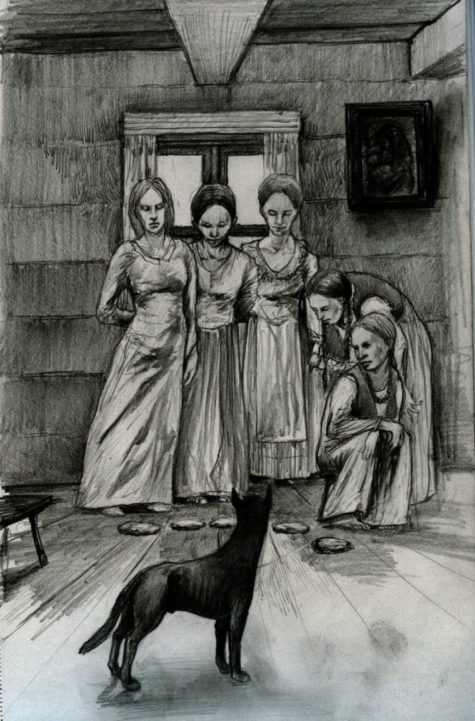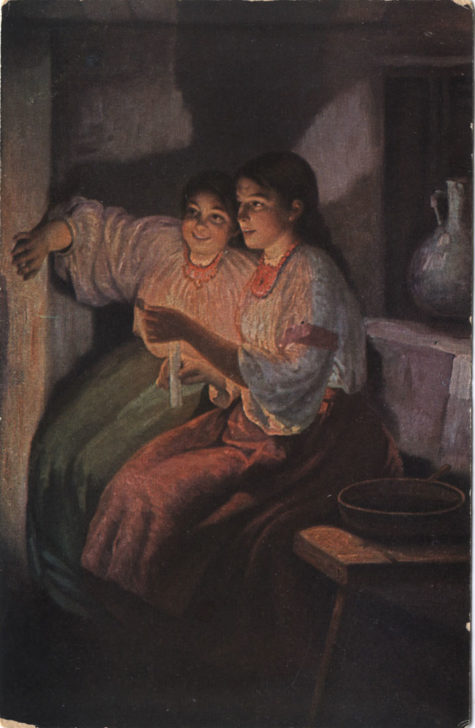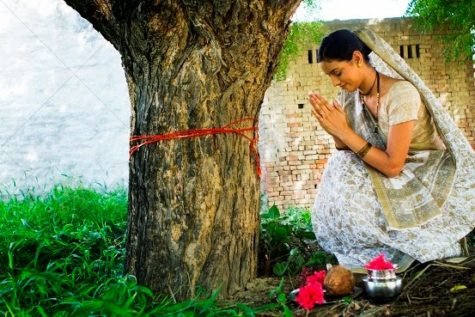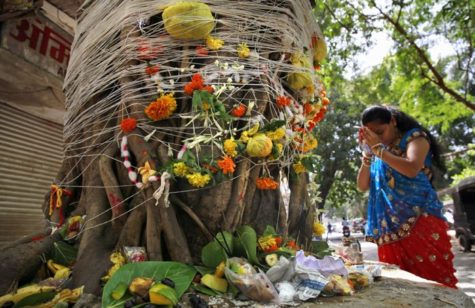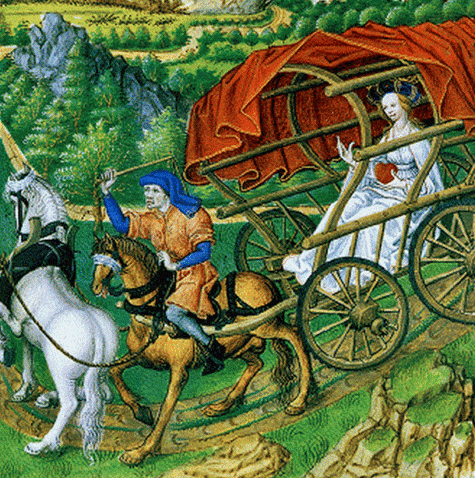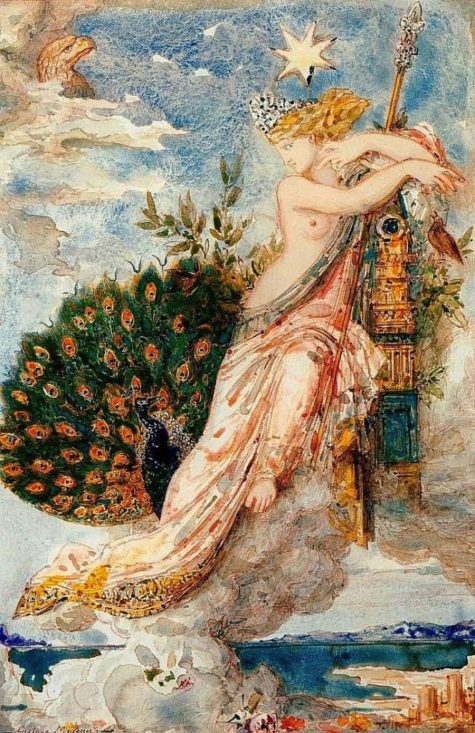Marriage
This is a feast celebrated on the night of 29th/30th November. It’s believed to be a magical night suitable for the love spells, and was celebrated throughout the centuries mostly by the unmarried people who wanted to reveal their future husband or wife.
Similar feasts are also observed for example in some parts of Ukraine, Slovakia, Russia, Germany, Austria and Romania.
A Bit of History
The original name of these celebrations was lost in history. The oldest historical sources confirm that this kind of custom was an old tradition in Poland already around 14th-15th centuries. Information about Polish women who were sentenced to death for conducting wax divinations (described below) can be found in 16th-century documents.
Nowadays the Poles celebrate primarily the Andrzejki (St.Andrew’s Eve), but some remnants of a similar feast of Katarzynki also survived – it was celebrated on the Eve of St. Catherine / Katarzyna (24th/25th Nov), and survived the longest in the region of Biskupin.
It is said that Andrzejki was dedicated primarily to the girls who wanted to know more about their future partner, and Katarzynki was the best for the boys to make divinations.
The Divinations
The most popular form of divination in Poland is pouring hot wax onto cold water. The wax is first melted over fire in a small mug, and then poured through a keyhole. People wait until it hardens properly in the cold water, then the pieces of wax are held against a candle to produce shadow on a wall. Its shapes symbolize things that will happen in the upcoming year.
Instead of a key, in the old days people were using for example woven straw or a horseshoe. People who find it impossible to get a proper key sometimes cut a shape of a key out of hard cardboard. In the past many people used melted lead instead of the wax for the divination.
Other popular divinations include a race of shoes. People gathered in the room take off one of their shoes and everyone places them in one line on the floor. The last shoe in the line is carried to the front – the process is repeated until one of the shoes reaches the front door and crosses the theshold.
Originally it symbolized a girl leaving her home, and owner of the lucky shoe who ‘went out’ (crossed the treshold) first was believed to become the first from the group to get married in the future.
The shoe race can be sometimes manipulated by tilting of the line.
Some old divinations also involve the house pets – cats or dogs. Each person prepares a small bowl with treats – for example milk for a cat or pieces of meat for a dog – and then places it on the floor. Owner of the bowl from which the pet eats first was believed to become the first to get married or find their true love (it depended on the intentions of the divination).
In the old days the treats were prepared very carefully – they were for example small cakes made of certain ingredients, mixed with water that was gathered in a certain way from a well or a brook (brought home for example only in a red mug or only in your own mouth), and baked over fire that was ignited with a wood plank borrowed (or stolen) from a neighbor.
If the pet runs away out of the room with the treat, it was also a good sign meaning a marriage (symbolic crossing of the threshold). However, if the animal hides under a bed with the treat, it meant death of the food’s owner. If the food is only bitten and left in the bowl or close to it, it meant that the partner would break up.
Other popular divination rituals require preparing of pieces of paper with names of the crushes written on it. In one of the versions the paper (preferably in a shape of a heart) is then turned around and pierced with a pin to reveal which of the names is the future spouse. The paper can be also pinned to a wall and serve as a dartboard.
In another version, much older, the people prepare small strips of paper, in a form of lots, and put them under the pillow – they draw one in the morning right after waking up.
Regardless of the version, the papers should always have at least one empty spot / one empty lot in case neither of the chosen names is the destined one.
Before another popular game of divination the people prepare mugs, flipped upside-down, and hide a symbolic accessory under each of them. The mugs are shifted around, and a person (with their eyes covered) chooses one. The hidden accessory indicates the future. It could be for example a ring or a female cap meaning marriage; a twig of rue or a dry leaf meaning spinsterhood / bachelorhood; a rosary, its beads, or a cross meaning a religious life or even life in a monastery; a coin meaning a wealthy life (but not necessarily full of love); a doll meaning an illegitimate child. One mug should be always empty – it means that nothing will change in the nearest future.
Marriage divination has dozens of regional types in Poland, and often take forms of various games or competitions. Many customs are sadly forgotten or not practiced anymore, only being told in stories by the oldest generations.
In the modern days the people treat Andrzejki as a special night that strengthens and ensures effectiveness of various divinations – many of modern activities come also in forms that are known worldwide, for example reading cards or tea leaves. Among most of the modern Polish society the divinations are no longer taken seriously, and are only an occasion for a unique once-in-a-year party, very often combined with celebrations of Andrzej’s namesday.
Source: Lamus Dworski
The dates for this ritual varies from year to year. The word ‘Purnima’ means full moon, therefore the Vat purnima vrat is observed on the full moon day (15th day) of the Hindu month of Jyeshtha that is during the month of May-June as per the Gregorian calendar. In 2017, this falls on June 9. In 2018 it will fall on June 27.
Vat Purnima or Wat Purnima (वट पूर्णिमा, vaṭapūrṇimā, also called Vat Savitri is a celebration observed by married women in the Western Indian states of Gujarat, Maharashtra, Karnataka and some regions of eastern Uttar Pradesh. On this Purnima, a married woman marks her love for her husband by tying a ceremonial thread around a banyan tree. The celebration is based on the legend of Savitri and Satyavan as narrated in the epic Mahabharata.
The Legend:
The legends dates back to a story in the age of Mahabharata. The childless king Asvapati and his consort Malavi wish to have a son. To have a child, he performed penances and offered prayers. Finally the God Savitr appears and tells him he will soon have a daughter. The king is overjoyed at the prospect of a child. She is born and named Savitri in honor of the god.
Since she was born due to her father’s severe penances, she naturally led an ascetic life. However, she is so beautiful and pure,all the men in her village are intimidated and no man will ask for her hand in marriage. Her father tells her to find a husband on her own. She sets out on a pilgrimage for this purpose and finds Satyavan, the son of a blind king named Dyumatsena who lives in exile as a forest-dweller. Savitri returns to find her father speaking with Sage Narada who tells her she has made a bad choice: although perfect in every way, Satyavan is destined to die one year from that day.
Her father asked her to find someone else, but she refused, saying that she could select a man only once in a lifetime since she was of an ascetic spirit. Narada and her father agree. Savitri insists on going ahead and marries Satyavan.
 Three days before the foreseen death of Satyavan, Savitri takes a vow of fasting and vigil. Her father-in-law tells her she has taken on too harsh a regimen, but she replies that she has taken an oath to perform the regimen and Dyumatsena offers his support. The morning of Satyavan’s predicted death, he is splitting wood and suddenly becomes weak and lays his head in Savitri’s lap and dies.
Three days before the foreseen death of Satyavan, Savitri takes a vow of fasting and vigil. Her father-in-law tells her she has taken on too harsh a regimen, but she replies that she has taken an oath to perform the regimen and Dyumatsena offers his support. The morning of Satyavan’s predicted death, he is splitting wood and suddenly becomes weak and lays his head in Savitri’s lap and dies.
Savitri places his body under the shade of a Vat (Banyan) tree. Soon, the messengers of Yama appear on the scene to take away her husband, but Savitir refuses to hand her husband over to them. They can not take him away until Lord Yama Himself appears. Savitri follows him as he carries the soul away. She offers him praise. Lord Yama, impressed by both the content and style of her words, and seeing her matchless devotion, spiritual knowledge, and determination, offers her a boon.
She first asks for eyesight and restoration of the kingdom for her father-in-law, then a hundred children for her father, and then a hundred children for herself and Satyavan. The last wish creates a dilemma for Yama, as it would indirectly grant the life of Satyavan. However, impressed by Savitri’s dedication and purity, he asks her to wish one more time, “forgetting” to mention his denial to grant the third wish.
Savitri immediately asked for the life of Satyavan. The death god Yama who does not spare even an ant, grants life to Satyavan and blesses Savitri’s life with eternal happiness.
Satyavan awakens as though he has been in a deep sleep and returns to his parents along with his wife. Meanwhile, at their home, Dyumatsena regains his eyesight before Savitri and Satyavan return. Since Satyavan still does not know what happened, Savitri relays the story to her parents-in-law, husband, and the gathered ascetics. As they praise her, Dyumatsena’s ministers arrive with news of the death of his usurper. Joyfully, the king and his entourage return to his kingdom.
Though the tree does not play a significant role of the story, The banyan tree holds a unique significance in Hindu religion. As per the Hindu scriptures, it holds the essence of the three great Gods in Hindu mythology, Brahma-Vishnu-Mahesh. The roots represents Brahma, the stem of Vat Vriksha is Vishnu while Shiva represents the upper part. It is believed that performing the rituals of the puja under this sacred tree, the devotees can fulfill all their desires. It is also worshiped in memory of the love in the legend.
Observing the Vat Purnima:
The festival is followed by married women only, and is prohibited for children and widows. On this day wives pray to the Divine for their husbands’ prosperity and longevity by performing Vat Purnima Puja Vidh which includes tying ritual threads around the trunk of a banyan tree; this ritual is also called the Peepal Puja.
In the present day, the festival is celebrated in the following way. Women dress in fine saris and jewelry, and their day begins with the offering of any five fruits and a coconut. Each woman winds white thread around a banyan tree seven times as a reminder of their husbands. They fast for the whole day.
The fast is also sometimes observed throughout the night until the next morning. The next morning women break their fast and offer charity to Brahmins. Women engage in the worship of a banyan tree, and listen to the legend of Savitri.
After, the women offer water to the tree and spread red powder (kumkum) on it, cotton threads are wrapped around the tree’s trunks and they do parikrama or circumambulate seven times around it.
Alternatively, on the occasion of Vat Purnima, women keep a fast of three days for their husbands, as Savitri did. During the three days, pictures of a Vat (banyan) tree, Savitri, Satyavan, and Yama, are drawn with a paste of sandal and rice on the floor or a wall in the home. The golden engravings of the couple are placed in a tray of sand, and worshiped with mantras (chanting), vermilion, saffron, sandalwood incense, fruit, and Vat leaves.
Outdoors, the banyan tree is worshiped. A thread is wound around the trunk of the tree, and copper coins are offered. Strict adherence to the fast and tradition is believed to ensure the husband a long and prosperous life. During the fast, women greet each other with “जन्म सावित्री हो” (English: “Become a Savitri”). It is believed that until the next seven births their husband will live well.
Just in the way that Savitri got her husband, Satyavan back from Yumraj, it is known that women who observe this auspicious fast will be blessed with good fortune and blissful married life.
Information collected from various sources.
This is the name given to two festivals held in ancient Boeotia, which was a part of Greece, in honor of the reconciliation of Hera and Zeus. The dates of these festivals are somewhat nebulous and varied from place to place and year to year. One source cites March 10th.
The story:
According to the myth, Hera and Zeus quarreled and Hera went away to Euboea and refused to return to his bed. To trick her into coming back and on the advice of Cithaeron, Zeus dressed up a carved oak-trunk to resemble a bride and let it be known that he planned to marry Plataea, the daughter of Asopus. Hera was so angry she tore the clothes from the statue, discovered the deception, and was so pleased that the two were reconciled.
The festivities:
The Lesser Daedala (Δαίδαλα μικρά) was held every four to six years. The people of Plataea went to an ancient oak grove and exposed pieces of cooked meat to ravens, attentively watching upon which tree any of the birds, after taking a piece of meat, would settle. Out of this tree they carved an image, and having it dressed as a bride, they set it on a bullock cart with a bridesmaid beside it. The image seems then to have been drawn to the bank of the river Asopus and back to the town, attended by a cheering crowd.
After fourteen of these cycles (approx.59 or 60 years), the Greater Daedala (Δαίδαλα μεγάλα) was held, and all Boeotia joined in the celebration. At its start one wooden figure was chosen from the many that had accumulated through the years and designated the “bride”. The wooden figure was prepared as a bride for a wedding, ritually bathed in the Asopus, adorned and raised on a wagon with an attendant. This wagon led a procession of wains carrying the accumulated daedala (all the other images that had been created over the years) up to the summit of Mount Kithairon, where a wooden sacrificial altar was erected out of square pieces of wood.
This was covered with a quantity of dry wood, and the towns, persons of rank, and other wealthy individuals, offered each a heifer to Hera and a bull to Zeus with plenty of wine and incense, while at the same time all of the daedala were placed upon the altar. For those who did not possess sufficient means, it was customary to offer small sheep, but all these offerings were immolated in a hecatomb in the same manner as those of the wealthier persons. The fire consumed both offerings and altar
An ancient account of myth behind the festival is related by Pausanias:
“Hera, they say, was for some reason or other angry with Zeus, and had retreated to Euboia. Zeus, failing to make her change her mind, visited Kithairon, at that time despot in Plataea, who surpassed all men for his cleverness. So he ordered Zeus to make an image of wood, and to carry it, wrapped up, in a bullock wagon, and to say that he was celebrating his marriage with Plataia, the daughter of Asopus. So Zeus followed the advice of Kithairon.
Hera heard the news at once, and at once appeared on the scene. But when she came near the wagon and tore away the dress from the image, she was pleased at the deceit, on finding it a wooden image and not a bride, and was reconciled to Zeus. To commemorate this reconciliation they celebrate a festival called Daidala, because the men of old time gave the name of daidala to wooden images… the Plataeans hold the festival of the Daidala every six years, according to the local guide, but really at a shorter interval.
I wanted very much to calculate exactly the interval between one Daedala and the next, but I was unable to do so. In this way they celebrate the feast.”
Found at Wikipedia
The first (or only) full moon in June is called the Honey Moon. Tradition holds that this is the best time to harvest honey from the hives.
Correspondences:
- Colors: Sun colors — gold, yellow, orange
- Gemstones: Topaz, agate
- Trees: Oak, maple
- Gods: Isis, Cerridwen, Persephone
- Herbs: Parsley, mosses, skullcap, mugwort
- Element: Earth
This is the month where magical workings are well suited to maintaining and enhancing things you already have. Weed your garden, prune the bushes, give your lawn all the tender loving care it needs. Take time to let your personal life blossom as well – focus on things that improve your job or education, as well as your relationships with family and friends.
This time of year, between the planting and harvesting of the crops, was the traditional month for weddings. This is because many ancient peoples believed that the “grand [sexual] union” of the Goddess and God occurred in early May at Beltaine. Since it was unlucky to compete with the deities, many couples delayed their weddings until June.
June remains a favorite month for marriage today. In some traditions, newly wed couples were fed dishes and beverages that featured honey for the first month of their married life to encourage love and fertility. The surviving vestige of this tradition lives on in the name given to the holiday immediately after the ceremony: “The Honeymoon.”
In June, we’re beginning to see some early summer fruits and vegetables (a great time for strawberry crops!), and the days are getting longer and longer. It’s a far cry from the darkness of winter, and we typically try to spend as much time outside as possible. Also known as Lover’s Moon, Long Sun Moon, it’s a time for bonding with friends and family, and forging what connections we can. Nurture your relationships, your garden, your career, and your soul this month.
In pre-historic times, summer was a joyous time of the year for those Aboriginal people who lived in the northern latitudes. The snow had disappeared; the ground had thawed out; warm temperatures had returned; flowers were blooming; leaves had returned to the deciduous trees. Some herbs could be harvested, for medicinal and other uses. Food was easier to find. The crops had already been planted and would be harvested in the months to come.
The festival of Juno begins on June 1st and continues through June 2nd.
- Themes: Femininity; Love; Relationships; Romance; Kinship; Time; Protection (Women and Children); Leadership.
- Symbols: Cypress; Peacocks; Cuckoo; Luxurious Clothing; Figs; Moon (or Silver Items)
About Juno:
The supreme goddess of the Roman pantheon, Juno offers a helping hand in every aspect of our relationships, especially the safety and happiness of women and children in those settings. Juno is also a very modern minded goddess, taking an active role in public life and finances. Beyond this, she rules women’s cycles, giving her connections with the moon. Art depicts Juno always wearing majestic clothing befitting the “Queen of Heaven.”
To do today:
According to Roman folklore, marrying during the Festival of Juno (June 1st or 2nd) ensures a long, happy relationship. So, if you’re planning a wedding or an engagement, or even moving in together, Juno can bless that commitment if you time the big step for today! As part of your devotion ritual, don’t forget to wear special clothing (perhaps something your partner especially likes) to invoke Juno’s attention and loving energy.
If you’d like to connect with Juno’s feminine force, her leadership skills, or her sense of timing within yourself, eat some fig-filled cookies today (or just some figs), saying:
Juno, bring _______ to my spirit, my wish fulfill.
By your power, through my will.
Fill in the blank with whatever aspect of Juno you most need to develop.
Found in: 365 Goddess



